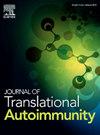偶联抗dsdna和抗染色质抗体在系统性红斑狼疮患者随访监测中的附加价值
IF 3.6
Q2 IMMUNOLOGY
引用次数: 0
摘要
目的对染色质(Chr)或核小体成分(双链DNA和组蛋白)的自身免疫反应通常与系统性红斑狼疮(SLE)的发展有关。相关自身抗体(Ab)是异质性的,其中抗dsdna抗体是分类标准的一部分,推荐用于监测狼疮发作和治疗反应。然而,抗dsdna Ab生物标志物的性能较弱;因此,可以提出将抗dsdna与抗chr Ab偶联,这也是本研究的目的。方法在这项2009 - 2024年的单中心研究中,从646名患者中回顾性选择了269例SLE患者并提供随访信息,其中包括325例抗dsdna和/或抗chr Ab (Bioplex 2200™)阳性的SLE患者。随访期间的生物临床信息通过医疗记录在几个时间点进行评估,以探索抗dsdna /Chr Ab谱与疾病表现之间的关系,以及抗dsdna /Chr Ab波动与疾病活动之间的关系,使用临床SLEDAI-2K,需要特异性治疗的耀斑,以及治疗反应。结果在随访分析中,根据诊断(116/269,43.1%)或发作(153/269,56.9%),将SLE患者细分为3个血清学组:dsDNA/Chr双阳性组(DP+, 190/269: 70.6%),其次是单阳性组(SP-C+, 42/269: 15.6%)和单阳性组(SP-D+, 37/269: 13.8%)。DP +组在随访期间出现重要的抗dsdna /Ab变异,有发生狼疮性肾炎的风险(56.8%,SP-C+组为2.4%,SP-D+组为29.7%,p <;0.04)和血清炎(30% vs 9.5% SP-C+组,p = 0.006)。在随访期间,SP-C+和SP-D+组的抗dsdna和Chr Ab水平随着时间的推移保持稳定,而与疾病活动、发作和治疗反应无关。对于DP +组,疾病活动性与抗dsdna (RmCorr = 0.46, p = 1.6x110-91)和抗chr (RmCorr = 0.38, p = 2.8x10-60) Ab水平相关,可用于预测耀斑。在引入治疗后,DP +组的所有患者都出现了Ab减少,完全缓解者报告的效果更为明显。结论:在疾病开始/爆发时,结合抗dsdna和抗chr Ab检测可以确定内源性类型,这有助于跟踪疾病活动,预测狼疮性肾炎/浆膜炎,并预测DP +组的治疗反应。本文章由计算机程序翻译,如有差异,请以英文原文为准。
The added value of coupling anti-dsDNA and anti-chromatin antibodies in follow-up monitoring of systemic lupus erythematosus patients
Objective
The autoimmune response to chromatin (Chr) or one of the nucleosome components (double stranded (ds)DNA and histones) is typically associated with the development of systemic lupus erythematosus (SLE). Related autoantibodies (Ab) are heterogeneous and, among them, anti-dsDNA Ab are part of the classification criteria and recommended for monitoring SLE with regards to lupus flares and therapy responses. However, anti-dsDNA Ab biomarker performances are weak; therefore, coupling anti-dsDNA with anti-Chr Ab can be proposed, which is the aim of this study.
Methods
In this single center study from 2009 to 2024, 269 SLE patients with follow-up information were retrospectively selected from a population of 646 individuals, including 325 SLE patients, who tested positive for anti-dsDNA and/or anti-Chr Ab (Bioplex 2200™). Bio-clinical information during follow-up were assessed at several time points through medical records in order to explore associations between the anti-dsDNA/Chr Ab profile with disease presentation, and anti-dsDNA/Chr Ab fluctuations with disease activity using clinical SLEDAI-2K, flares requiring specific treatment, and the therapeutic response.
Results
At inclusion in the follow-up analysis, corresponding to diagnosis (116/269, 43.1 %) or flare (153/269, 56.9 %), SLE patients were subdivided into three serological groups: the double positive dsDNA/Chr group (DP+, 190/269: 70.6 %), followed by the single positive Chr group (SP-C+, 42/269: 15.6 %), and the single positive dsDNA group (SP-D+, 37/269: 13.8 %). The DP + group, which presented important anti-dsDNA/Ab variations during follow-up, was at risk to develop lupus nephritis (56.8 % versus 2.4 % in SP-C+ and 29.7 % in SP-D+ groups, p < 0.04) and serositis (30 % versus 9.5 % in SP-C+ group, p = 0.006). During follow-up, anti-dsDNA and Chr Ab levels in the SP-C+ and SP-D+ groups remained stable over time irrespective of disease activity, flares, and therapeutic response. Regarding the DP + group, disease activity was correlated with both anti-dsDNA (RmCorr = 0.46, p = 1.6x110-91) and anti-Chr (RmCorr = 0.38, p = 2.8x10-60) Ab levels, which can be used to predict flares. Following therapy introduction, Ab reduction occurred in all patients from the DP + group with a more pronounced effect reported in complete responders.
Conclusion
coupling anti-dsDNA with anti-Chr Ab detection at disease initiation/flare allows definition of endotypes, which is useful to follow disease activity, predict lupus nephritis/serositis, and anticipate therapeutic response in the DP + group.
求助全文
通过发布文献求助,成功后即可免费获取论文全文。
去求助
来源期刊

Journal of Translational Autoimmunity
Medicine-Immunology and Allergy
CiteScore
7.80
自引率
2.60%
发文量
33
审稿时长
55 days
 求助内容:
求助内容: 应助结果提醒方式:
应助结果提醒方式:


